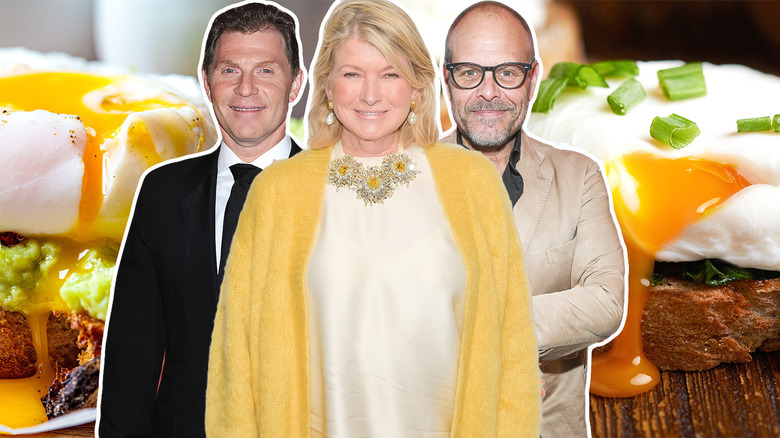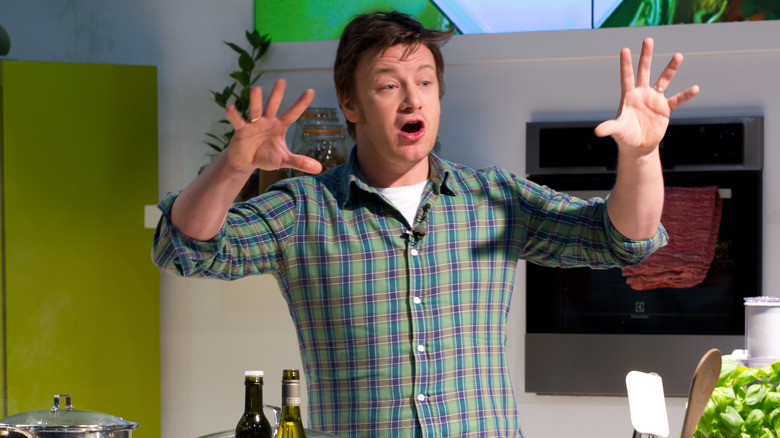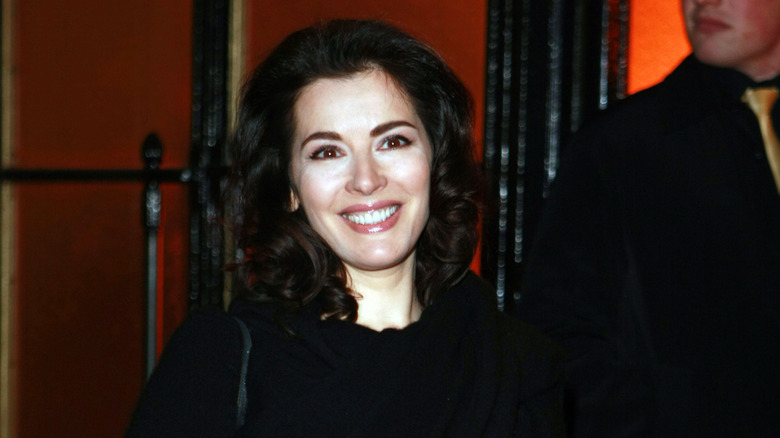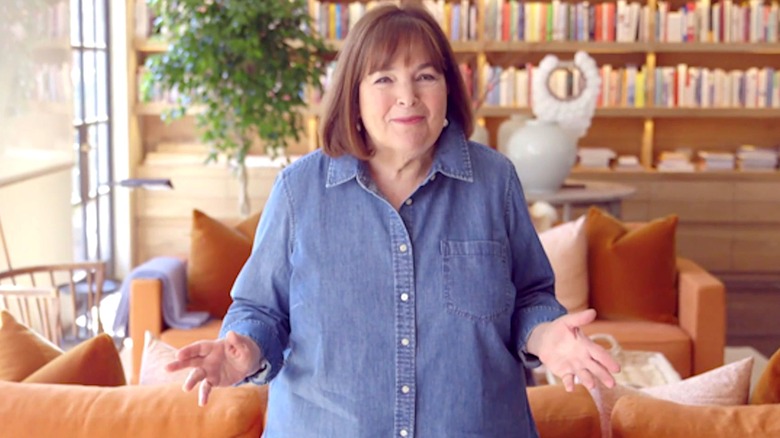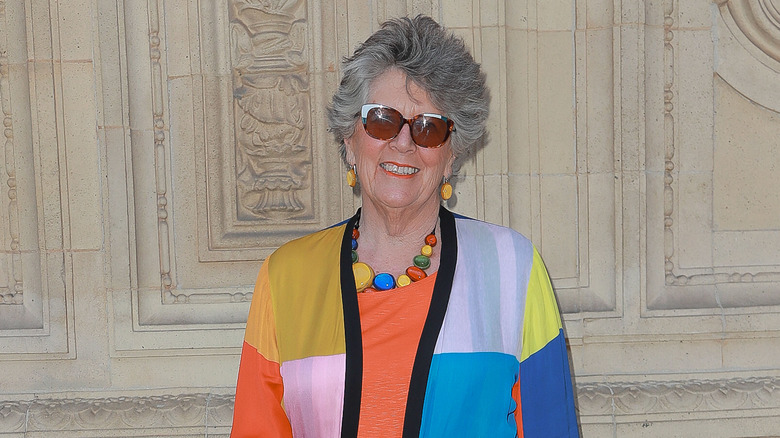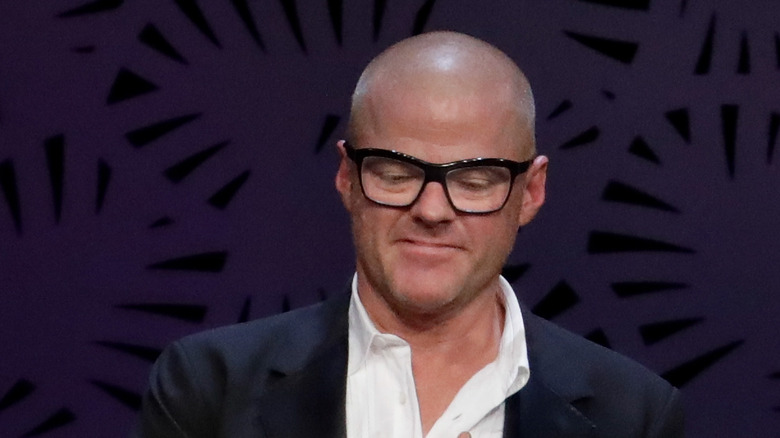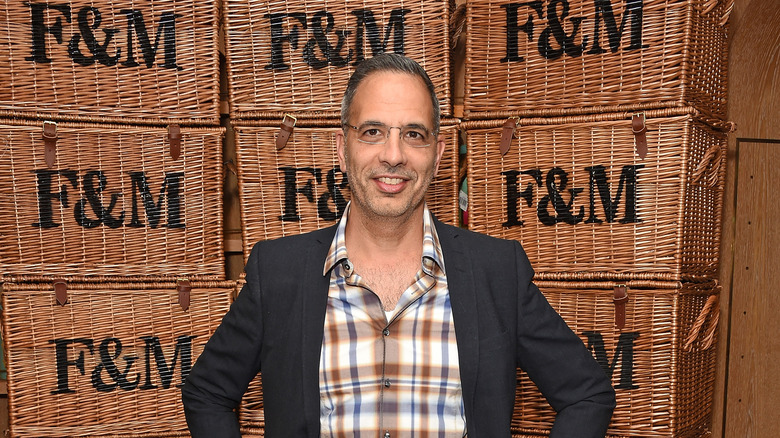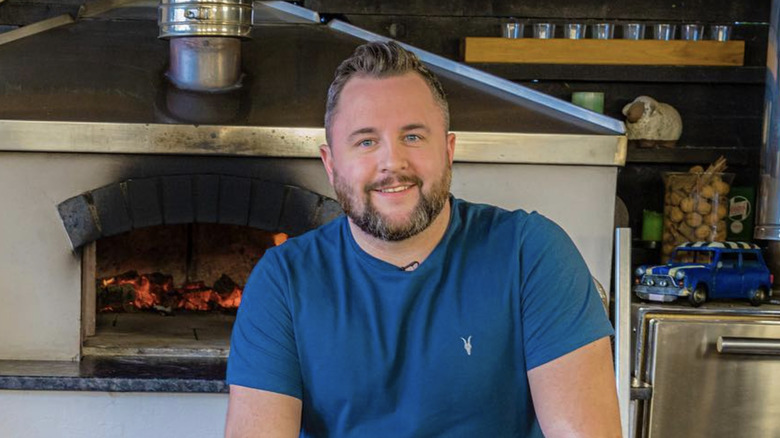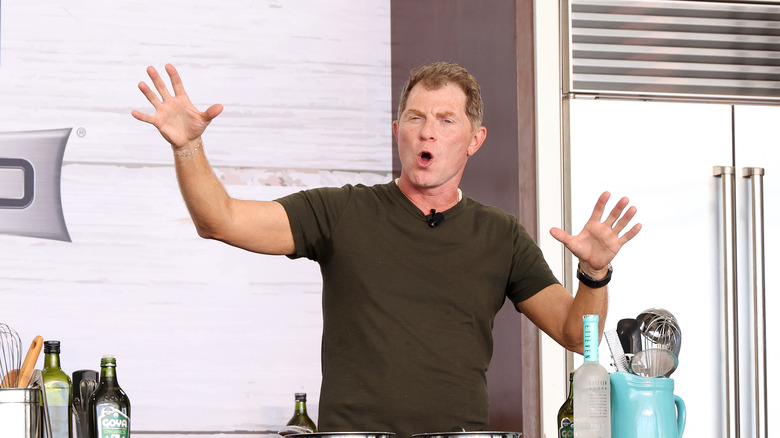14 Celebrity Chef Tips For Perfectly Poached Eggs
There's nothing like a perfectly poached egg. The term "poached" comes from the word "poché," meaning pocket in French, which is a perfect description of this delicate pocket of deliciousness when it's done right. Making a poached egg, which simply involves boiling an egg in water without its shell, may seem simple, but it's a deceptively difficult task.
Even for a seasoned home chef, poaching eggs can be an intimidating task. Sometimes, you crack your egg into a boiling pot of water, and the white disintegrates, and you end up with murky water and barely any egg left to serve. Other times, you can cook the egg too long, and you're left with a rubbery ball that no restaurant would dare serve its customers.
Well, those days are over. Over the years, a whole host of professional chefs have developed a long list of tips and tricks that can help you nail down your method to enjoy fool-proof poached eggs every time. Read on for our list of celebrity chefs' best methods for poaching an egg, and you'll be doing it like a pro in no time.
Julia Child pricks her eggs with a pin
Julia Child is the undisputed darling of French cooking in the United States. After training in Paris, she brought the best of the French culinary tradition back across the Atlantic and made it accessible to novice cooks. And Julia Child's tip for perfect poached eggs is one of the most useful nuggets of gastronomic information that she bequeathed to Americans:
To execute Julia's simple, unexpected trick, all you need (apart from the standard egg poaching equipment) is a pin. Using the sharp point of the pin, gently prick the fat end of the egg to form a tiny hole. Don't worry about a mess; the hole is too small for any of the egg's liquid to escape. Next, place the egg (with the shell still on) in a pot of boiling water for ten seconds. Using a slotted spoon, remove the egg from the water and allow it to cool, which shouldn't take more than a few seconds. After that, simply poach the egg as you normally would! The process helps the egg hold its shape when it's cracked so that you don't end up with those annoying stringy whites that often show up when poaching an egg.
Gordon Ramsay adds white wine vinegar
It's no secret that when it comes to cooking, Gordon Ramsay thinks there's only one way — and that's his way. There is a lot you can learn from this famously demanding, hard-headed celebrity chef, and one of Gordon Ramsay's best tips for home chefs has to do with how he poaches his eggs.
To get that perfectly firm egg white that holds its shape, Ramsay recommends that you add two tablespoons of white wine vinegar to the water in your pot before you poach your eggs. It turns out there's a scientific explanation for this method: Egg whites cook and become firm when they denature, which means that the proteins in them change shape and become solid. Egg proteins denature when they're heated and also when they're exposed to an acidic environment. Adding vinegar to the hot water increases the egg whites' rate of solidifying, leaving you with a less wispy, more firm, and intact egg white, which is what you're after when you poach eggs.
Martha Stewart uses a small bowl or ramekin
We all know Martha Stewart wouldn't be caught dead presenting a meal that was less than perfection. The home chef, decorator, and undisputed queen of domestic entertainment have exacting standards for everything she produces, including her poached eggs. Of all of Martha Stewart's egg dish tips (and there are many), her tip to make the perfect poached eggs is simple, effective, and easy to follow.
Instead of cracking eggs directly into the hot water in your saucepan, first break each egg into a separate small bowl or ramekin. From there, once your water is ready, simply bring the vessel right above the center of the pot and gently tip it until the egg slides into the water. This method gives you superior control over cracking an egg directly into the water. This ensures that when the egg hits the water, it doesn't splatter all over the place but holds its shape so that you end up with a neat poached egg instead of a big eggy mess.
Jamie Oliver creates a whirlpool
Jamie Oliver is known for his down-to-earth, easy-going approach to cooking, which has earned him several television shows and a number of published cookbooks. For over ten years, he's been teaching home chefs how to do everything from making perfect tiramisu to growing your own vegetable garden. So when it comes to Jamie Oliver's trick for poaching eggs, we're all ears.
Before you place the egg in the water, use a spoon and stir the water in one direction to create a whirlpool in the center of the pot. Once you've done this, place the raw egg in the center of the vortex. As you'll be able to see when you employ this technique, the water moves around the egg, keeping the egg white from spreading too much. Be sure to get the whirlpool moving rapidly, otherwise there won't be enough movement to get the white to wrap itself around the yolk.
Nigella Lawson adds lemon juice to her raw egg
British cooking legend Nigella Lawson has been inviting us into her home for years to share tips and tricks that make cooking easier and more approachable. With her numerous cookbooks and television shows, she is one of the United Kingdom's most trusted authorities when working in the kitchen. Even with this stunning list of accomplishments, she admitted on her website that she'd "always been frightened of egg-poaching." Lucky for us, Nigella Lawson's trick for poached eggs is simple and easy to employ at home.
She cracks her egg into a small bowl, adds a tablespoon of lemon juice or vinegar to the raw egg, and lets it sit while she brings a pot of water up to a simmer, usually taking a few minutes. When the water has reached the desired temperature (just before bubbles start to form), she slips the egg out of the bowl and into the water, leaving the residual liquid behind in the bowl.
Tom Kerridge turns the stove off
British chef Tom Kerridge is famous for being the brains behind The Hand and Flowers, which enjoys the distinction of being the only pub in the United Kingdom that has two Michelin stars. With this distinction, Kerridge moved on to making television appearances and writing cookbooks and has become one of the leading British authorities when it comes to pub food. With his years of cooking experience, it's safe to say Kerridge has poached a few eggs in his time.
The secret to perfect poached eggs, he claims, is to bring the water in your sauce pot to a boil and then, right when you drop the egg into the center of the simmering water, turn the stove off and let it sit for four to five minutes. This process cooks the eggs more slowly than the traditional method in which you leave the pot simmering, which ensures that the whites cook all the way through and leave a perfectly jammy yolk.
Chrissy Teigen uses cookie cutters
Tired of trying to poach an egg only to have the whites splatter everywhere in the pot and leave you with a big mess? So is Chrissy Teigen, the model, influencer, and (most importantly) foodie who has taken the world of domestic cooking by storm with her popular and relatable tips and tricks for cooking easy, healthy meals at home. And what's her secret for making the perfect poached egg that sits lightly on an English muffin for an Instagrammable and delicious Eggs Benedict? Cookie cutters.
Teigen uses a shallow saute pan instead of the traditional deep saucepan to poach her eggs and keep them in shape; she places each egg inside a three-inch cookie cutter to prevent the whites from feathering out. Not only does this give you a perfectly circular cooked egg, but you can easily poach more than one egg at a time without worrying about the eggs spreading into each other.
Ina Garten stores her eggs outside the fridge
Ina Garten, the celebrity chef and former host of the wildly popular Barefoot Contessa show on Food Network, can do just about anything in the kitchen, and that includes poaching an egg. The unique way Ina Garten makes poached eggs has less to do with the method than with the preparation of her ingredients.
Garten recommends keeping your eggs outside the refrigerator before you poach them. If you drop a cold egg into the hot water to poach it, it will take longer for the eggs to cook because it will lower the temperature of the water. When a room-temperature egg hits the hot water, the outside of the egg will cook faster, which means it doesn't have a chance to feather out. Garten is also (controversially) in the anti-vinegar camp. She claims that acidity is not necessary if you follow her other rules and can affect the taste of your poached eggs.
Alton Brown poaches in a nonstick pan
Alton Brown is the master of kitchen hacks. The celebrity chef has been the host of Good Eats on the Food Network for the last fourteen years, during which he has dispensed valuable cooking tips to food lovers across the United States. And one of Alton Brown's best cooking tips for home chefs has to do with the way he poaches eggs.
Brown is famous for using scientific principles and precision when it comes to cooking. When you're making poached eggs, he recommends a nonstick pan and fill it with exactly an inch and a half of water. When the water temperature reaches 190 degrees Fahrenheit, use a spoon to scrape the bottom of the pan to get rid of the bubbles that form during the heating process. Then place your eggs gently in the water for four minutes and thirty seconds and remove them with a slotted spoon. Make sure your pan is nonstick so that the eggs don't stick to the bottom.
Prue Leith swears by fresh eggs
Prue Leith made a career out of her no-nonsense approach to cooking. Her ferociously high standards (as well as her killer sense of style) on the Great British Baking Show have made her famous on both sides of the Atlantic. In this video, Leith describes why fresh eggs are suited for poaching.
As eggs age, the whites become runnier, which makes them more susceptible to feathering out when they hit the water, leaving you with a big wet mess instead of a tight, solid poached egg. If you're not sure whether your egg is fresh, all you need to do is place it in a bowl of water. If the egg sinks, it's fresh, and you can go ahead and poach it. If the egg floats, it is still fine to eat, but it probably won't make the best-poached egg. This is because as eggs age, they absorb air, making them more buoyant.
Heston Blumenthal strains his eggs
Not many chefs have the distinction of having three Michelin stars under their belts. But that isn't the case for Heston Blumenthal, the head chef at The Fat Duck, a restaurant outside London that was voted the world's best restaurant in 2005 by The World's 50 Best Restaurants. Needless to say, when Blumenthal has a tip, we listen to it.
His tip requires two simple kitchen tools: a ramekin and a slotted spoon. Break your egg into the ramekin, which gives you more control when you pour it into a slotted spoon. This method strains off the wispy edges of the egg white and leaves you with only the firmer part, which will remain more cohesive when the egg is placed in the water. Gently lower the egg into the hot water using the slotted spoon, and you're likely to impress with a perfectly poached egg.
Yotam Ottolenghi poaches his eggs in a shakshuka sauce
Yotam Ottolenghi is one of the greats of modern Middle Eastern cooking. Born in Israel, Ottolenghi now calls the United Kingdom home, with several restaurants in London that serve some of the finest foods inspired by his homeland. And the best way to poach eggs, According to Ottolenghi, has a distinctly Middle Eastern flair.
Instead of dropping your eggs to cook in a saucepan full of water, he suggests that instead, you poach your eggs in a shakshuka sauce. You certainly won't be lacking flavor when you make shakshuka, which involves onions, peppers, and a host of herbs and spices that are sure to elevate your poached eggs to the next level. Also, because the tomato sauce is thicker than water, the eggs stay put and don't spread. You won't regret trying this fire-roasted shakshuka recipe, which is best enjoyed with toasted bread.
Paul Foster keeps an eye on his eggs
Paul Foster, the head chef at Salt, a Michelin star restaurant in England, is an up-and-coming star in the British food scene. He made his mark by making creative, quality food in an unpretentious environment and is the author of the cookbook Salt, which is named after his restaurant.
With years of experience in different kitchens, Foster knows that not all stoves were created alike. He recommends that after you place the egg in the hot water, you set a timer for two minutes. After that, test the firmness of the egg by using a slotted spoon to lift it out of the water and shake it around a bit to check if it has reached the desired consistency. Although it probably won't be ready after just two minutes, it's important to keep an eye on your eggs so that you don't end up with a rubbery, overcooked product or whites that are too runny.
Bobby Flay gives his poached eggs an Italian twist
Few chefs have had the meteoric rise of Bobby Flay. The James Beard Award-winning chef, who began his journey as a contestant on Iron Chef America, is now a household name across the country. And his tip for making poached eggs may surprise you.
After using some time-tested tricks to poach his eggs, including the saucepan swirl and vinegar that we've already covered, Flay's contribution to the art of poached eggs is what he does once his eggs are done cooking. First, he places them on a toasted piece of bread with olive oil and then makes a vinaigrette with honey and Dijon mustard. He whisks some parmesan cheese into the mixture, tops the eggs with it, and grinds some black pepper on top for a poached egg-centered take on a classic cacio e pepe. Bobby Flay's Italian poached egg twist is wildly clever.
